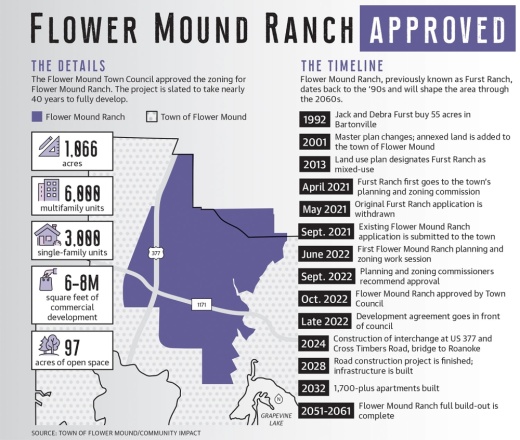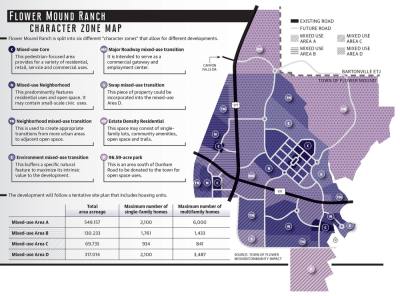The 1,066-acre development, previously known as Furst Ranch, spans from the intersection of Cross Timbers Road to US 377, and was rezoned from agricultural district and interim holding to mixed-use District 2 on the town zoning map during Flower Mound Town Council’s Oct. 3 meeting.
Randi Rivera, director of planning and entitlement for McAdams—the company handling the project’s land planning—said during the October council meeting the development will be a “town within a town” at full build-out, which is expected to take 30-40 years.
“We’ve talked about it being a place where the only time you have to leave is to go to the airport,” Rivera said. “All of your needs would be met at Flower Mound Ranch.”
The plan allows for the construction of 6,000 multifamily units, 3,000 single-family homes and 6 million-8 million square feet of commercial buildings. The plan limits construction to 1,700 apartments after the first 100,000 square feet of commercial development, plus one unit per additional 1,000 square feet of commercial space.
While many in the community have expressed support for development coming to western Flower Mound, the plan has also been met with its fair share of pushback from residents over traffic, schooling and residential density concerns. Opinions were split on Town Council as well, with the ordinance passing by a 3-2 vote.
However, it will likely be a few years before any visible changes take place in the area. After the Town Council looks at the development agreement and tax increment reinvestment zone in the coming months, improving streets and infrastructure will be the first step in the development, according to town officials.
“This is just the first phase, and I think everybody should be aware of that,” said Jim Engel, Flower Mound Town Council member. “I don’t expect dirt to be moved for two, three years.”
Project scope
Plans for Flower Mound Ranch have been in the works for decades before reaching this point in the process.
Land owner Jack Furst said his work on the Flower Mound Ranch project began in 1991.
Furst submitted his initial application to the town in April 2021 under the name Furst Ranch. That application was withdrawn one month later, and the existing proposal was submitted, complete with a name change to Flower Mound Ranch.
Before any major vertical development begins, the developer must first address street needs, according to Rivera.••Multiple street construction projects are planned, including an interchange at the development’s main intersection with US 377 becoming an overpass.
That project is set to begin in 2024. Rivera also said there are plans for a bridge to Roanoke, and the “need for that improvement is imminent.”
In addition, the water and sewage infrastructure growth in Phase 1—a section in the southwest portion of Flower Mound Ranch—was approved by the town’s SMARTgrowth plan. Any developments outside of that area would need to go through the approval process before starting construction.
“The point is to put infrastructure as needed, incrementally over time, to ensure everyone has the services they need,” Rivera said.
Community concerns
While plans are moving forward, the Flower Mound Ranch project has been met with pushback from the community.
Mayor Pro Tem Sandeep Sharma and Council Member Adam Schiestel were the two members of council to vote against the zoning ordinance Oct. 3.
“I was open to apartments, but the number was just too high for me to just smile and say, ‘Aye,’” Sharma said.
Schiestel added that he felt the density of the project was not in line with Flower Mound’s identity.
“This project occupies roughly 3%-3.5% of the land in Flower Mound, but what they were proposing was over 20,000 residents. Flower Mound has 80,000 [residents], so it’s 25% of our current residents on 3% of our land,” Schiestel said. “I would prefer something that is lower density, even if it’s mixed-use, but a mixed-use project that is more of a Flower Mound-type of a project.”
With Flower Mound Ranch being such a large project, Schiestel said he was looking for more checkpoints.
“There’s not another point for the council to come in and say, ‘Wait a minute; maybe this isn’t going how we expected,’” Schiestel said.
One of the concerns that comes with the population increase for many is the possible strain on Argyle ISD. The Flower Mound Ranch is entirely within AISD, and Furst included 50 acres in his plan for the construction of an elementary school and middle school.
“The district is currently studying the future enrollment impact of this phased development with the district’s demographic consultants,” AISD officials said in an Oct. 5 news release. “Early projections include AISD enrolling its first students from this development during the 2027-2028 school year.”
Sharma said he felt the town did not do enough to lower the density.
“There are so many components that will be great; I just want to make it better, because we can,” Sharma said. “I voted no because I think some components are compromised. ... Every city around us—Grapevine, Coppell, Lewisville, Irving and everything around the airport—is pretty much [built out]. And we are not done yet because we didn’t compromise.”
Looking ahead
Because the Flower Mound Ranch project is on such a large scale, there are no renderings or definite plans for what the area will look like down the road, said Lexin Murphy, the town’s planning services director.
“A lot of what we see in Flower Mound are planned developments where they know exactly how the site is going to develop. This is such a large area, and so they didn’t have that level of detail yet,” Murphy said. “Everybody had to wrap their mind around how to look at this more from a form-based perspective and think about development standards that should apply regardless of what goes into any specific area of development.”
While the specifics are not yet known, plenty of development is planned for the project. That includes the estimated 9,000 residential units, 6 million-8 million square feet of commercial development, 97 acres of parkland, a 12-mile trail system, two schools and a major hotel/resort.
Because the project is slated to include development opportunities, Flower Mound Chamber President Lori Walker called the project a “win-win” for the town.
“It will be such a revenue-generating engine for all of North Texas,” Walker said. “As a 24-year resident of Flower Mound, this is really one of the most exciting things that I think we will ever see in our community. And from where I sit as the president of the chamber, all of our businesses are stronger together. It makes our current business here stronger and helps everyone succeed.”
Those development prospects are also the major reason Engel voted in favor of the ordinance. He said bringing development to the west side of Flower Mound has been a priority since he took office in 2018.
“There are no services [in western Flower Mound] for the residents. There’s no retail; they don’t even have a gas station for miles and miles,” Engel said. “This is going to bring those things to them, and they can spend their tax dollars in Flower Mound versus contributing to another community. ... It’s going to take a while to get rolling, but this project is huge, it’s enormous—and I just think this is going to be spectacular.”






